|
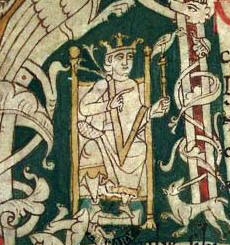
William I the Conqueror 1028(?)-1087
William's real name was Guillaume because he was French. He was
a smart and very determined man.
|
|
Among other nicknames, William answered
to William the Bastard (Guillaume le B�tard) and
William of Normandy (Guillaume de Normandie.)
Of course, his favorite nickname was
William the Conqueror (Guillaume le Conqu�rant.) |
Who Ruled France at the Time?
That was the
 Capetian family with Henry I
at the time, who was
king of France from 1026 - 1059. Henry's son Philip I ruled
France from 1059 - 1108.
Capetian family with Henry I
at the time, who was
king of France from 1026 - 1059. Henry's son Philip I ruled
France from 1059 - 1108.
William's Family
William's father was Robert I of Normandy.
William's mother
was Herleva, also called Arlette. Herleva was Robert's
concubine, which explains the byname William the Bastard.
When Robert died in 1035, the only heir
was wee William. Thus, William became William II, the new
duke of Normandy.
Later, his mother married again and had
three children from a Viscount Herluin. Hence, William had
two stepbrothers and a stepsister.
One of William's half brothers was
Odo.
In 1052, William married Matilda.
Matilda was the daughter of Baldwin V of Flanders.
William and Matilda had four sons,
Robert, Richard, William Rufus, and
 Henry.
They also had several daughters. One of them was Adela. Henry.
They also had several daughters. One of them was Adela.
The Miracle
The miracle in William's story simply consists of the fact that he
wasn't killed as a child. William was an illegitimate heir of a
substantial inheritance surrounded by many family members who would
have only benefited from his death.
THE BATTLE OF Val-�s-Dunes
The battle of Val-�s-Dunes, also called the Battle of
Val-aux-Dunes, was fought in 1047 in the neighborhood of
Caen, northern France.
Who fought?
William and his king, Henry I,
who defeated the rebellious barons of Normandy.
Becoming the King of
England
During his lifetime, English King Edward the Confessor
apparently had the urge to make people happy. So what if he promised
several individuals the throne upon his death.
He wouldn't be around to have to deal with the mess.
One of the people in hope and waiting was Edward's brother-in-law
 Harold. Another
one was above mentioned William, duke of Normandy.
Harold. Another
one was above mentioned William, duke of Normandy.
Edward died January 5, 1066. The English
gave Harold the crown and the Normans prepared for a trip.
On September 27, 1066, William and his
troops sailed direction England, thus starting the
 Norman
Conquest.
Norman
Conquest.
On October 14, 1066, Harold was killed
in the
 Battle of Hastings, in Sussex, England. For nine
months, Harold had been Harold II King of England. Now it was
William's turn to rule.
Battle of Hastings, in Sussex, England. For nine
months, Harold had been Harold II King of England. Now it was
William's turn to rule.
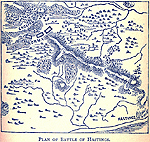
1066 Battle of Hastings
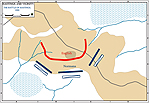
1066 Battle of Hastings (USMA)
Being now English King William I, the
Conqueror cleaned house, replaced British government officials with
pals from Normandy, and started with the construction of the
Tower of London.
The years of the reign of William the Conqueror, 1066-1087, were marked
by frequent risings of the English against him, which were quelled
mercilessly.
In December 1085, William commissioned a survey
of his new English kingdom, the summary of which became known as the
Domesday Book. It is the earliest
surviving public record and the piece of which everybody at the UK
National Archives is very proud.
The Domesday Book lists name of owner or
occupier of a certain stretch of land, the kind of livestock that
was kept, the value of the land, and of course the amount of tax
owed to the Crown, as well as bodies able to render military
services.
Originally, the project was called the
Great Inquisition or Survey.
The English nicknamed it in reference to
the finality of Doomsday, the day of God's final judgment. God's
ruling would also be written in a book and that would be the end of
all discussion. No chance to apply for re-evaluation. You're doomed.
Not to be confused with
 D-Day.
D-Day.
Short Biography of
William I the Conqueror
1028 Birth in Falaise, Normandy, France
1035 Becomes William II, duke of Normandy
1047 Battle of Val-�s-Dunes
1052 Marries Matilda
1054 Battle of Mortemer
1058 Battle of Varaville
1066, September 27 Sets sail for England
1066, October 14 Battle of Hastings
1066, December 25 Crowned king of England
1086 Compilation of the Domesday Book
1087, September 9 Death in Rouen, Normandy, France
And here are more maps
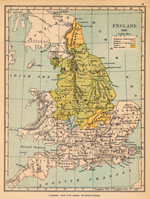
1065 England
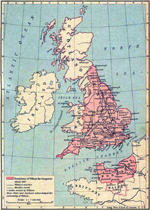
Dominions of William the Conqueror about 1087
Click map to enlarge
See also the chart
 Governments in History.
Governments in History.
More History
|